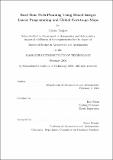| dc.contributor.advisor | Eric Feron. | en_US |
| dc.contributor.author | Toupet, Olivier | en_US |
| dc.contributor.other | Massachusetts Institute of Technology. Dept. of Aeronautics and Astronautics. | en_US |
| dc.date.accessioned | 2007-01-10T15:34:58Z | |
| dc.date.available | 2007-01-10T15:34:58Z | |
| dc.date.copyright | 2006 | en_US |
| dc.date.issued | 2006 | en_US |
| dc.identifier.uri | http://hdl.handle.net/1721.1/35290 | |
| dc.description | Thesis (S.M.)--Massachusetts Institute of Technology, Dept. of Aeronautics and Astronautics, 2006. | en_US |
| dc.description | This electronic version was submitted by the student author. The certified thesis is available in the Institute Archives and Special Collections. | en_US |
| dc.description | Includes bibliographical references (leaves 93-95). | en_US |
| dc.description.abstract | With the advance in the fields of computer science, control and optimization, it is now possible to build aerial vehicles which do not need pilots. An important capability for such autonomous vehicles is to be able to generate their own path to navigate in a constrained environment and accomplish mission objectives, such as reaching waypoints in minimal time. To account for dynamic changes in the environment, perturbations, modeling errors and modifications in the mission scenario, the trajectory needs to be continuously re-optimized online based on the latest available updates. However, to allow for high update rates, the trajectory optimization problem needs to be simple enough to be solved quickly. Optimizing for a continuous trajectory of a dynamically-constrained vehicle in the presence of obstacles is an infinite-dimension nonlinear optimal control problem. Such a problem is intractable in real-time and simplifications need to be made. In this thesis, the author presents the mechanisms used to design a path-planner with real-time and long-range capabilities. The approach relies on converting the optimal control problem into a parameter optimization one whose horizon can be reduced by using a global cost-to-go function to provide an approximate cost for the tail of the trajectory. | en_US |
| dc.description.abstract | (cont.) Thus only the short-term trajectory is being constantly optimized online based on a mixed integer linear programming formulation that accounts for the vehicle's performance. The cost-to-go function presented in this thesis has the feature to be tailored to both the environment and the vehicle's maneuvering capabilities. The author then implements and demonstrates a path-planner software based on the presented approach for a real unmanned helicopter, the Renegade, that flew within the DARPA SEC program. A full description of the capabilities and functions supported by the planner software are provided. Hardware-in-the-loop simulation results are provided to illustrate the performance of the system. | en_US |
| dc.description.statementofresponsibility | by Olivier Toupet. | en_US |
| dc.format.extent | 95 leaves | en_US |
| dc.format.extent | 675590 bytes | |
| dc.format.extent | 640919 bytes | |
| dc.format.mimetype | application/pdf | |
| dc.format.mimetype | application/pdf | |
| dc.language.iso | eng | en_US |
| dc.publisher | Massachusetts Institute of Technology | en_US |
| dc.rights | M.I.T. theses are protected by copyright. They may be viewed from this source for any purpose, but reproduction or distribution in any format is prohibited without written permission. See provided URL for inquiries about permission. | en_US |
| dc.rights.uri | http://dspace.mit.edu/handle/1721.1/7582 | |
| dc.subject | Aeronautics and Astronautics. | en_US |
| dc.title | Real-time path-planning using mixed-integer linear programming and global cost-to-go maps | en_US |
| dc.type | Thesis | en_US |
| dc.description.degree | S.M. | en_US |
| dc.contributor.department | Massachusetts Institute of Technology. Department of Aeronautics and Astronautics | |
| dc.identifier.oclc | 73816440 | en_US |
